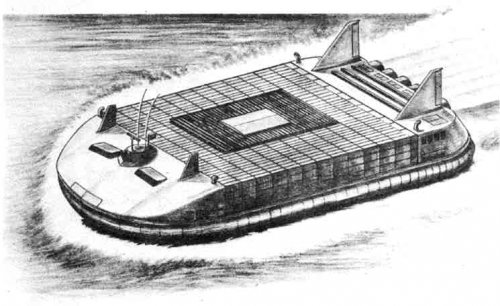Kascak, A. F.; Rom, F. E. The Potential of Nuclear Power for High-Speed Ocean-Going Air-Cushion Vehicles NASA Lewis Research Center September 1, 1969
Abstract:
Rom, F. E. Airbreathing Nuclear Propulsion, A New Look NASA Lewis Research Center
January 1, 1971
Abstract:
Masser, C. C.; Rom, F. E. Nuclear Powered Air Cushion Vehicles for Transoceanic Commerce NASA Lewis Research Center May 1, 1971
Abstract:
Anderson, J. L.; Finnegan, P. M. Air Cushion Vehicles: A Briefing NASA Lewis Research Center October 1, 1971
Abstract:
http://ntrs.nasa.gov/archive/nasa/casi.ntrs.nasa.gov/19720011364_1972011364.pdf
Rom, F. E. Airbreathing Nuclear propulsion: A New Look NASA Lewis Research Center
December 1, 1971
Abstract:
Artist's concept of a 5,000 ton nuclear-powered ocean-going air cushion vehicle (ACV) freighter.
Abstract:
http://ntrs.nasa.gov/archive/nasa/casi.ntrs.nasa.gov/19690026345_1969026345.pdfNuclear power plants based on nuclear aircraft technology to power ocean-going air cushion vehicles.
Rom, F. E. Airbreathing Nuclear Propulsion, A New Look NASA Lewis Research Center
January 1, 1971
Abstract:
http://ntrs.nasa.gov/archive/nasa/casi.ntrs.nasa.gov/19710016048_1971016048.pdfPotential feasibility of safe, practical, and economical air breathing nuclear propulsion system for aircraft and air cushion vehicles.
Masser, C. C.; Rom, F. E. Nuclear Powered Air Cushion Vehicles for Transoceanic Commerce NASA Lewis Research Center May 1, 1971
Abstract:
http://ntrs.nasa.gov/archive/nasa/casi.ntrs.nasa.gov/19710016307_1971016307.pdfCharacteristics and cost analysis of nuclear powered air cushion vehicles for oceanic commercial operations.
Anderson, J. L.; Finnegan, P. M. Air Cushion Vehicles: A Briefing NASA Lewis Research Center October 1, 1971
Abstract:
Experience and characteristics; the powering, uses, and implications of large air cushion vehicles (ACV); and the conceptual design and operation of a nuclear powered ACV freighter and supporting facilities are described.
http://ntrs.nasa.gov/archive/nasa/casi.ntrs.nasa.gov/19720011364_1972011364.pdf
Rom, F. E. Airbreathing Nuclear propulsion: A New Look NASA Lewis Research Center
December 1, 1971
Abstract:
http://ntrs.nasa.gov/archive/nasa/casi.ntrs.nasa.gov/19720004955_1972004955.pdfNuclear-powered air-cushion vehicles using lightweight aircraft-type nuclear powerplants show promise of carrying transoceanic cargo at cost-per-metric-ton-kilometer (cost-per-ton-n mi) rates comparable to railroad rates. These rates are independent of the distance traveled. Cargo rates for nonstop distances of 4000 n mi are expected to be less than one-half those for similar fossil-fueled air-cushion vehicles. For 6000-n mi nonstop distances, the rates are expected to be less than one-sixth as much. There are no fundamental technical reasons why subsonic nuclear aircraft cannot be made to fly successfully if the gross weight is over 1 million lb. Public safety of airborne nuclear powerplants is receiving the greatest attention in low-level experimental and analytical investigations. Idealized model containment vessels which have been impacted on reinforced concrete showed no leaks after impact at velocities to 400 mph. The experiments indicate feasibility of impacting at speeds over 600 mph with no leaks.
Artist's concept of a 5,000 ton nuclear-powered ocean-going air cushion vehicle (ACV) freighter.

